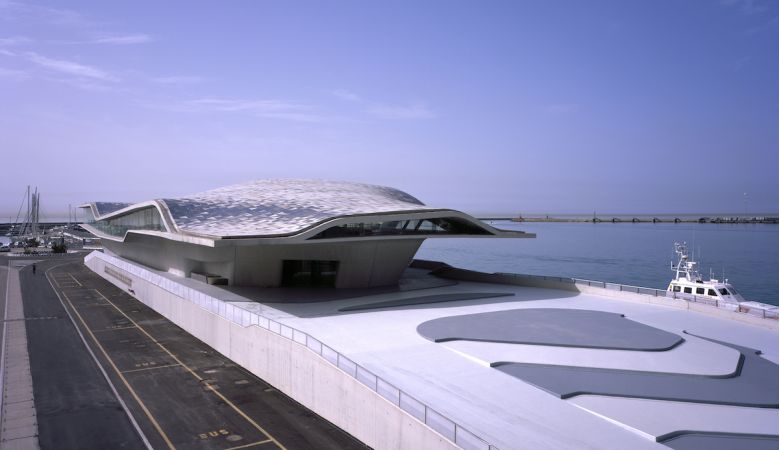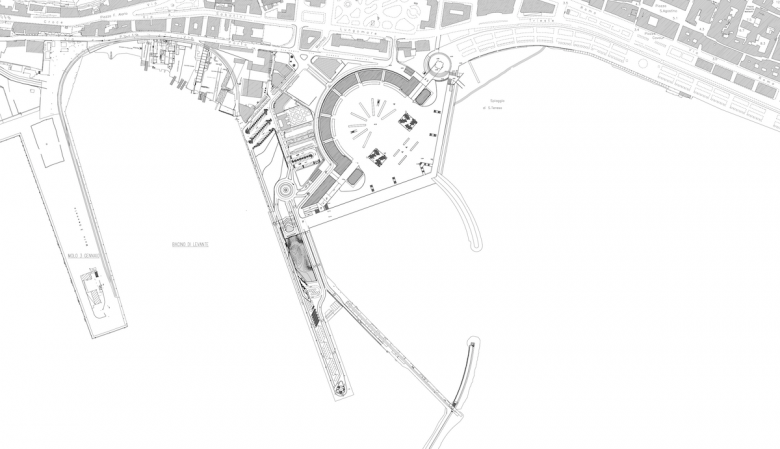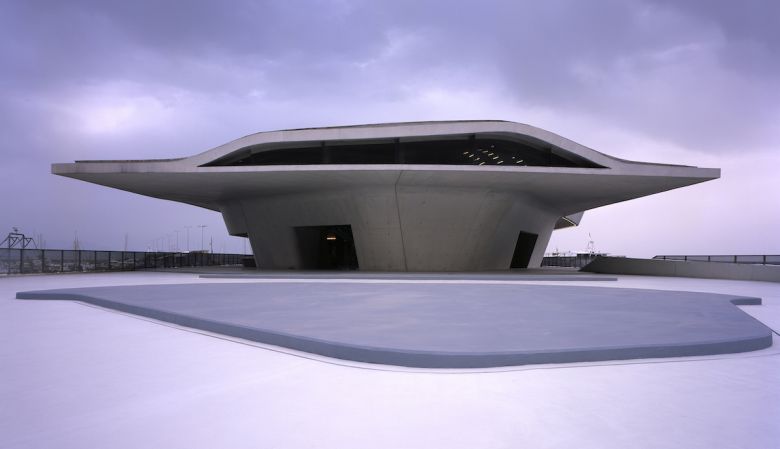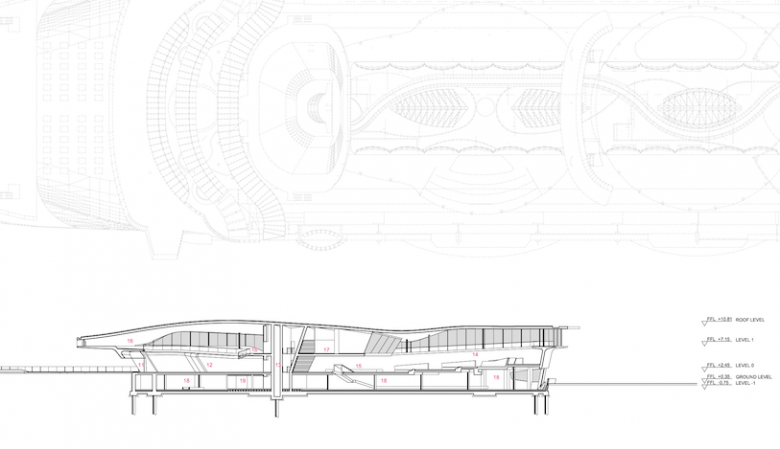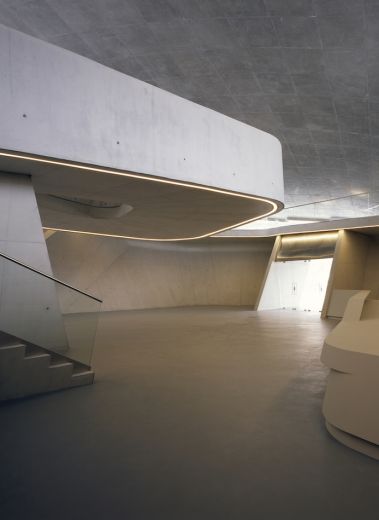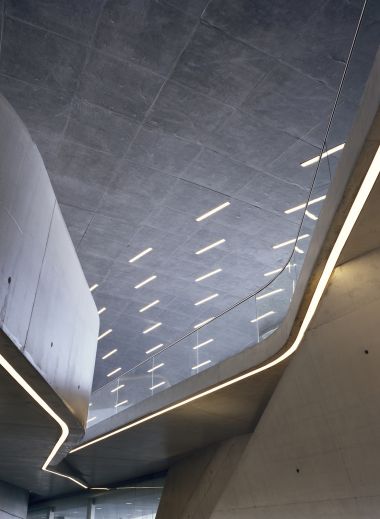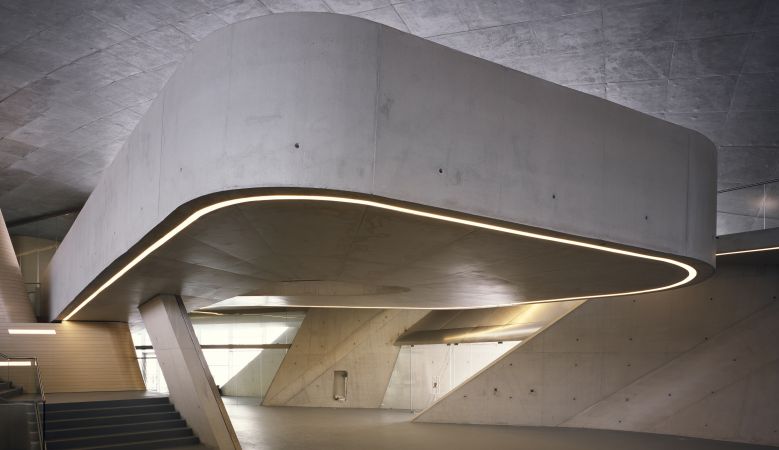JOIN the AFICIONADOS
Get the insider news and lowdown on what we've been up to, where we've been, and who we've met along the way. Be the first to discover new places and get the scoop on our favourites.
A concrete oyster rises from the edge of the Tyrrhenian Sea, its curved form arresting in silhouette and impossible to ignore. This is the Salerno Maritime Terminal – a striking work by Zaha Hadid Architects located in the southern Italian port city of Salerno, where it functions not only as a travel hub but as a sculptural intervention on the Cilento coastline.
Completed in 2016, the terminal was one of the last major civic projects signed off by Zaha Hadid before her death. It stands as a powerful testament to her architectural ethos – where form never exists without narrative, and where movement, material and metaphor are bound into a single vision.
Positioned between the iconic Amalfi Coast and the wilder, more under-the-radar Cilento, the terminal is part infrastructure, part public sculpture. A portal between land and sea, it serves as the embarkation and disembarkation point for cruise ships and ferries travelling throughout the Mediterranean. But this is no ordinary transit hub. With its low, asymmetric silhouette and fluid, organic geometry, the Salerno Maritime Terminal invites visitors to pause, to look, and to reflect – not just on where they are going, but on where they’ve arrived.
The building’s low-slung form echoes the landscape – curved like a natural rock formation worn smooth by sun and salt. At the same time, its exterior is deliberately abstract, a heavy, solid structure with a shell-like form that both shelters and encloses. The inspiration is openly biomorphic: Hadid described the design as resembling an oyster, with the terminal’s wide concrete canopy acting as a protective shell.
That shell is no aesthetic flourish. The terminal was designed with the harsh Campanian sun in mind. Its thick concrete walls absorb and modulate heat, keeping the interior cool even in high summer. Its irregular shape allows for natural shading and airflow, while the internal layout channels visitors through open volumes and under canopied walkways – more Mediterranean piazza than standard transport lounge.
The interplay between hard and soft, fluid and fixed, is key to the structure’s presence. From some angles, the terminal seems to blend into the seafront. From others, it juts out defiantly, challenging the traditional dockside vernacular. There are no unnecessary flourishes. Instead, Hadid’s hallmark curves do the talking – bold, controlled, and laden with intent.
The terminal acts as an in-between space – a threshold rather than a destination. But Hadid was never interested in making architecture that recedes into the background. The Salerno Terminal asserts itself as a place worth being in, not simply passing through.
Internally, the building offers wide, flowing circulation areas lit by angled skylights. The ceiling structure – ribbed and vaulted like a wave – creates a sense of continuous motion. Views are carefully framed: across the ferry docks, out to the Mediterranean, and over to the surrounding hills of the Amalfi and Cilento coasts.
The Salerno Maritime Terminal is, in this way, also a landscape observatory. Those waiting for ferries or disembarking cruise ships find themselves immersed in Southern Italy’s coastal geography – a blend of sea, sky, and sculpted stone that feels poetic rather than purely functional.
At night, the building transforms again. Illuminated from within, it glows softly on the shoreline like a futuristic lantern, serving as a maritime marker and a beacon of architectural ambition. It draws the eye from the sea and reassures those arriving by water that they are entering a city where design and imagination are prized.
Like the Port House in Antwerp, the Salerno Terminal carries the unmistakable stamp of Zaha Hadid’s vision – a desire to merge engineering and art, to create spaces that are as much about movement as they are about form. What makes this building particularly resonant is the way it connects to its surroundings – not just geographically, but emotionally.
Southern Italy has long been romanticised in art, architecture and literature. What Hadid offered here was something different – a reimagining of coastal identity through modernist principles. The terminal doesn’t echo the region’s Baroque facades or hilltop ruins. Instead, it speaks a new language – one of abstraction, materiality, and flow.
It is also, crucially, a public building. Open to all, the terminal avoids elitism. It welcomes locals, tourists, seafarers, and commuters alike. It doesn’t merely serve a function – it elevates the function, transforming the everyday act of arrival and departure into something expressive and spatially meaningful.
The Salerno Maritime Terminal reminds us that architecture is not just about shelter – it is about symbolism, story, and site. By shaping a space that feels both geological and futuristic, Hadid forged a new typology for Mediterranean port cities. She turned what could have been another transport shed into a work of architectural drama.
The building is also perfectly sited. From here, one can gaze across the Gulf of Salerno, trace the cliffs of the Amalfi Coast, or look south to the quiet beaches and ancient settlements of the Cilento Coast. This panorama, matched with the fluidity of the terminal’s interior, creates a sense of openness – a space in dialogue with its wider context.
And yet it is not just about beauty. It is about legacy. Zaha Hadid’s Salerno Terminal is a bold punctuation mark on Italy’s long architectural narrative – a curvaceous, concrete pause between departure and arrival, between tradition and progress.
